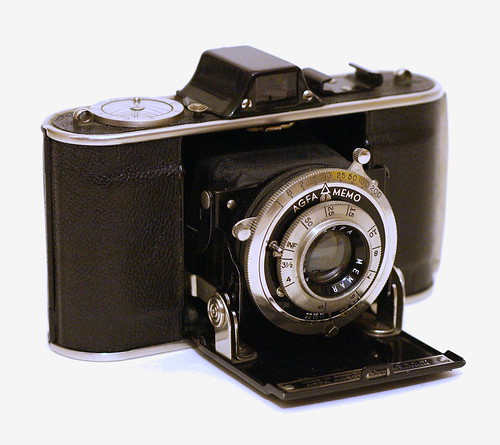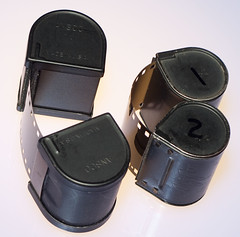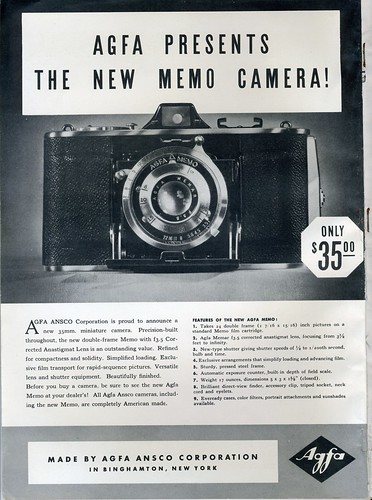Difference between revisions of "Agfa Memo"
m (minor wording changes) |
Hanskerensky (talk | contribs) (Added link to review) |
||
| (11 intermediate revisions by 6 users not shown) | |||
| Line 1: | Line 1: | ||
{{Flickr_image | {{Flickr_image | ||
| − | + | |image_source= http://www.flickr.com/photos/26262745@N08/4330760605/in/pool-camerawiki | |
| − | |image= http:// | + | |image= http://farm5.static.flickr.com/4067/4330760605_0346dd2ef1.jpg |
| − | |image_align= | + | |image_align= right |
| − | |image_text= Agfa Memo | + | |image_text= 1939 Agfa Memo |
| + | |image_by= Rick Oleson | ||
| + | |image_rights= with permission | ||
}} | }} | ||
{{Flickr_image | {{Flickr_image | ||
| − | ||image_source= http://www.flickr.com/photos/26092923@N02/4503629674/in/pool- | + | ||image_source= http://www.flickr.com/photos/26092923@N02/4503629674/in/pool-camerawiki |
| − | |image= http://farm3.static.flickr.com/2795/ | + | |image= http://farm3.static.flickr.com/2795/4503629674_e3967396c0_m.jpg |
|image_align= right | |image_align= right | ||
| − | |image_text= Ansco Memo | + | |image_text= Ansco Memo cassette (left) and<br/>Agfa Karat cassette (right) |
| + | |image_by= Jack Hufnagel | ||
| + | |image_rights= with permission | ||
}} | }} | ||
<br style="clear: left" /> | <br style="clear: left" /> | ||
| − | The | + | The '''Agfa Memo''', introduced in 1939, is a 35mm viewfinder camera using '''[[Ansco Memo]]''' film cartridges, first introduced in 1927. It is a metal-bodied horizontal folding camera. |
| − | The | + | The Ansco film cartridge (rather than the '''[[Agfa Karat]]''' film cartridge of 1936, which itself seems to have been inspired by the original [[Ansco Memo]] unit) appears to have been chosen for a number of reasons: |
| − | * The larger Ansco film cartridge | + | * The larger Ansco film cartridge holds twice as much film as the Agfa (24 exposures instead of 12) |
| − | * The camera, although | + | * The camera, although labelled as the ''Agfa'' Memo, was designed and produced at the former Ansco factory in Binghamton, New York. (In 1928 Ansco had merged with Agfa in the USA, and was thereafter known as the Agfa-Ansco Company). |
| − | * The older Memo film cartridge was more likely to be | + | * The older Memo film cartridge was more likely to be stocked in an American photography store than the newer Karat film cartridge. |
| − | * The | + | * The smaller Karat cartridge can still be used in the Memo, as a result of clever engineering, though one then needs to be careful to set the frame counter at 12 rather than at 24. The ability to use either cartridge was a definite advantage in the European market. However, Agfa Karat cameras can not utilize the larger Memo film cartridge. |
| + | <div class="floatright plainlinks" style="margin:0px 0px 15px 15px;"> | ||
| + | {{Flickr_image | ||
| + | |image_source= http://www.flickr.com/photos/nesster/5210013472/in/pool-camerawiki | ||
| + | |image= http://farm5.static.flickr.com/4088/5210013472_87dc419703.jpg | ||
| + | |image_align= right | ||
| + | |image_text= 1939 Agfa Memo advertisement | ||
| + | |scan_by= Nesster | ||
| + | |image_rights= public domain US no copyright | ||
| + | }} | ||
| + | </div> | ||
| + | The first versions of the Agfa Memo used the by-then standard 24x36mm image size; a nearly identical half-frame (18x24mm) version was introduced in 1940. Film advance is by a sliding knob in a horizontal slot on the camera's back plate which activates a claw-based film-advance mechanism, another design idea taken from the original [[Ansco Memo]] camera of 1927. The manually-reset 24-exposure frame indicator is similar to the Ansco Memo's, but is located next to the advance knob (which activates it) rather than on the front (where the Ansco Memo's is activated by the shutter release). A centrally located viewfinder is mounted on the top plate. | ||
| − | The | + | The Agfa Memo came equipped what some believe may be a [[Wollensak]] shutter<ref>[http://www.flickr.com/photos/26262745@N08/4330760605/in/set-72157610757987197/ Notes in the caption to a an Agfa Memo] in [http://www.flickr.com/photos/26262745@N08/ Rick Oleson's Flickr stream].</ref> (due to the design similarity to their Alphax shutter). Three different anastigmat lenses were used: f/3.5, f/4.5, and f/5.6, all without focal lengths indicated, and all marked with the name "Agfa Memar" - though it is likely that these uncoated lenses were supplied by Wollensak. The lenses measure approximately 50mm in focal length. |
| − | The Agfa Memo | + | The least expensive Agfa Memo has an f/5.6 lens (stopping down to f/22) and has front-element focusing down to 3.5 feet. The manually-cocked shutter has speeds of 1/25s, 1/50s, 1/100s, B, and T. These cameras are finished in a textured flat black paint. |
| − | The | + | The more expensive Agfa Memos have f/4.5 and f/3.5 lenses, which also focus to 3.5 feet. The manually cocked shutter has speeds of 1/2s to 1/200s, B, and T. These cameras are finished in black morocco leather and have a nickel-plated depth of field calculator to the right of the viewfinder. These cameras also have nickel-plated metal trim and a black accessory shoe to the left of the viewfinder. |
| − | + | None of the shutters are synchronised for flash. | |
| − | + | Production was halted by the start of the Second World War (late in 19''41'' in the US), as the government seized all Agfa-Ansco assets as enemy property. | |
| − | + | The initial price of the f/4.5 model was $25US ($380US in 2009), while the f/3.5 model sold for $35US ($535US in 2009) | |
| − | + | == Notes== | |
| − | |||
| − | |||
| − | |||
| − | |||
| − | |||
| − | |||
| − | |||
| − | |||
| − | |||
| − | |||
| − | |||
<references /> | <references /> | ||
| Line 51: | Line 55: | ||
* Life Magazine (April 17, 1939) advertisement | * Life Magazine (April 17, 1939) advertisement | ||
| − | [[Category: Ansco]] | + | ==Links== |
| − | [[Category: Agfa]] | + | *[https://mikeeckman.com/2021/08/agfa-memo-1939/ Agfa Memo review] at [https://mikeeckman.com/ Mike Eckman Dot Com] |
| + | |||
| + | [[Category:Ansco|Memo]] | ||
| + | [[Category:Agfa|Memo]] | ||
| + | [[Category:M|Memo Agfa]] | ||
[[Category: A]] | [[Category: A]] | ||
[[Category: USA]] | [[Category: USA]] | ||
[[Category: 35mm viewfinder]] | [[Category: 35mm viewfinder]] | ||
| + | [[Category: 1939]] | ||
Latest revision as of 04:50, 4 September 2023

|
| 1939 Agfa Memo image by Rick Oleson (Image rights) |

|
| Ansco Memo cassette (left) and Agfa Karat cassette (right) image by Jack Hufnagel (Image rights) |
The Agfa Memo, introduced in 1939, is a 35mm viewfinder camera using Ansco Memo film cartridges, first introduced in 1927. It is a metal-bodied horizontal folding camera.
The Ansco film cartridge (rather than the Agfa Karat film cartridge of 1936, which itself seems to have been inspired by the original Ansco Memo unit) appears to have been chosen for a number of reasons:
- The larger Ansco film cartridge holds twice as much film as the Agfa (24 exposures instead of 12)
- The camera, although labelled as the Agfa Memo, was designed and produced at the former Ansco factory in Binghamton, New York. (In 1928 Ansco had merged with Agfa in the USA, and was thereafter known as the Agfa-Ansco Company).
- The older Memo film cartridge was more likely to be stocked in an American photography store than the newer Karat film cartridge.
- The smaller Karat cartridge can still be used in the Memo, as a result of clever engineering, though one then needs to be careful to set the frame counter at 12 rather than at 24. The ability to use either cartridge was a definite advantage in the European market. However, Agfa Karat cameras can not utilize the larger Memo film cartridge.

|
| 1939 Agfa Memo advertisement scanned by Nesster (Image rights) |
The first versions of the Agfa Memo used the by-then standard 24x36mm image size; a nearly identical half-frame (18x24mm) version was introduced in 1940. Film advance is by a sliding knob in a horizontal slot on the camera's back plate which activates a claw-based film-advance mechanism, another design idea taken from the original Ansco Memo camera of 1927. The manually-reset 24-exposure frame indicator is similar to the Ansco Memo's, but is located next to the advance knob (which activates it) rather than on the front (where the Ansco Memo's is activated by the shutter release). A centrally located viewfinder is mounted on the top plate.
The Agfa Memo came equipped what some believe may be a Wollensak shutter[1] (due to the design similarity to their Alphax shutter). Three different anastigmat lenses were used: f/3.5, f/4.5, and f/5.6, all without focal lengths indicated, and all marked with the name "Agfa Memar" - though it is likely that these uncoated lenses were supplied by Wollensak. The lenses measure approximately 50mm in focal length.
The least expensive Agfa Memo has an f/5.6 lens (stopping down to f/22) and has front-element focusing down to 3.5 feet. The manually-cocked shutter has speeds of 1/25s, 1/50s, 1/100s, B, and T. These cameras are finished in a textured flat black paint.
The more expensive Agfa Memos have f/4.5 and f/3.5 lenses, which also focus to 3.5 feet. The manually cocked shutter has speeds of 1/2s to 1/200s, B, and T. These cameras are finished in black morocco leather and have a nickel-plated depth of field calculator to the right of the viewfinder. These cameras also have nickel-plated metal trim and a black accessory shoe to the left of the viewfinder.
None of the shutters are synchronised for flash.
Production was halted by the start of the Second World War (late in 1941 in the US), as the government seized all Agfa-Ansco assets as enemy property.
The initial price of the f/4.5 model was $25US ($380US in 2009), while the f/3.5 model sold for $35US ($535US in 2009)
Notes
Bibliography
- Kalton Lahue and Joesph Bailey, Glass, Brass, & Chrome - The American 35mm Miniature Camera, University of Oklahoma Press, 1972
- Life Magazine (April 17, 1939) advertisement